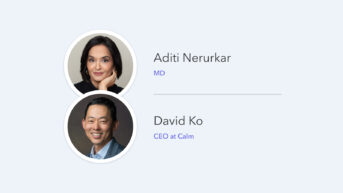“In a room of 30 people, 21 people are struggling with stress and burnout. So if you feel this way, you’re not alone. It’s not your fault,” said Dr. Aditi Nerurkar in her opening remarks in Calm Your Mind to Thrive at Work: A World Mental Health Day DIscussion, a webinar hosted by Calm.
Aditi Nerurkar, MD, MPH is a Harvard physician and speaker with expertise in stress, resilience, burnout, and mental health. She was joined in the webinar by Calm CEO David Ko and Chief of Staff Bennett Porter for a discussion of stress, resilience, and workforce mental health.
Here are 5 takeaways from their discussion:
1. The goal is not to have zero stress; it’s to live life with healthy, manageable stress
It’s important to know that not all stress is bad, explained Dr. Nerurkar. “There are two kinds of stress, and not all stress is created equal.”
According to Dr. Nerurkar, unhealthy stress (“maladaptive stress”) is the kind of stress that makes you feel bad and gets in the way of your everyday life. “The data shows that it can affect your parenting, your job performance, your productivity, your sleep, your mental health and physical health,” she said. Stress affects different people in different ways, she added. Some people get headaches or eyestrain, while others have abdominal pain, gastrointestinal issues, or weakness.
“However, there’s another type of stress called healthy stress, scientifically known as adaptive stress,” Dr. Nerurkar explained. “This [type of stress] is productive and moves your life forward.” Everything good in your life—a promotion, a new job, or a new relationship, for example—was created because of a little bit of healthy stress.
“The goal is not to live a life of zero stress. It’s actually biologically impossible,” she said. For instance, everyone needs a spike of the stress hormone cortisol to get out of bed in the morning. Instead, the goal is to “live a life with healthy, manageable stress that can serve you rather than harm you. And so we’re trying to bring down that level of unhealthy, unproductive kind of runaway-train stress back to healthy levels.”
2. Know your personal “tells” that you have unhealthy stress
The mind and body are deeply intertwined, explained Ko, but the historical perception that they’re distinct entities has led to their being treated separately. And while well-defined care pathways exist for treating physical ailments, they’re lacking in the treatment of mental health issues, he said.
“I would love one day for stress to be treated like blood pressure,” echoed Dr. Nerurkar. “We check every month. Are your medications working? Are your lifestyle interventions working? Are you seeing all of the right people? How’s your exercise? We can do the same for stress. It doesn’t have to be this vague thing.”
Outside the doctor’s office, the mind–body connection can help us understand when we need to take steps to address our stress, she added. According to Dr. Nerurkar, we all have a “personal tell”—like a canary in a coal mine that stops singing when the air gets bad, letting miners know it’s not safe—to help us identify stress that’s unhealthy. She shared that her personal tell is heart palpitations that can feel like “a stampede of wild horses across [her] chest.”
“Your brain and your body are talking to you and telling you, ‘Hey, pay attention. I think you’re stressed,’” said Dr. Nerurkar. It’s important to ask yourself what your tell is and “pay attention before it’s too late and it really becomes a stampede of horses like it did for me.”
3. Don’t fall into the trap of toxic resilience
There’s a false narrative about resilience today, Dr. Nerurkar said. “You’ve been told over the past several years, ‘Oh, just be more resilient. Take on this deadline. You can do more with less.’ We’ve all heard that messaging over and over, whether societally or in our workplaces or at home.
“That’s not true resilience from the scientific definition,” she explained. “It’s toxic resilience. The true definition of resilience is your innate biological ability to adapt, recover, and grow in the face of life’s challenges.”
Don’t believe the myth that you can’t get burned out because you’re resilient, she cautioned. “We’re all innately resilient; however, it’s the systems that burn us out.”
Instead, when experiencing symptoms of stress—heart palpitations, breathing trouble, or others—the first step is to consult a doctor to rule out other conditions, Dr. Nerurkar emphasized. If the doctor determines that stress alone is the reason for your symptoms, you don’t have to just accept that you have to live with it, she said. “You can find your way out of stress, and it doesn’t have to define your everyday life.”
4. Practical strategies can help you rewire your brain, and technology can help
The good news is that practical, science-backed, and cost-free ways to rewire your brain and manage stress exist, according to Dr. Nerurkar. For example, she practices a reset called Stop Breathe Be, one of the first techniques she learned when she was a stressed medical resident.
“It’s a three-second brain-rewiring exercise that taps into your mind-body connection. You stop whatever you’re doing, breathe, and . . . ground yourself in the here and now. Anxiety is a future-focused emotion. . . . What Stop Breathe Be does is get you out of what-if thinking and back to what’s in the here and now.” She said she also practices meditation and protects her sleep by avoiding late-night phone scrolling—“revenge bedtime procrastination.”
Dr. Nerurkar’s resets and practical strategies for managing stress are available in her book The 5 Resets: Rewire Your Brain and Body for Less Stress and More Resilience and her new series on Calm, Stress and Burnout Support.
Indeed, digital technology can play an important role in supporting someone’s mental health when the traditional healthcare system can’t, added Ko. Technology like Calm can “really help to bridge the gap” by offering effective tools for mindfulness and mental well-being while a person waits for a specialist they can meet with live. “This is where technology could really help you in your mental health journey.”
“If you’ve had a difficult experience and experienced trauma,” added Dr. Nerurkar, “tap into Calm and all of the various features that are available in the app.” She noted that she’s a long-time meditator and has used Calm meditations nearly daily for more than a decade.
5. Leaders need to focus on trusted solutions and outcomes
HR leaders have the best of intentions when they implement an employee assistance program, Ko said, but the reality is that employees have a hard time navigating what can seem like a sea of logos. “There are just so many apps out there today that we can choose from. It’s really hard to distinguish one from the other.” As a result, utilization of the solutions that HR leaders have put in place remains low.
Ko urges HR leaders to find solutions from a trusted brand. “What really stands out are trusted brands, and that trust has to be earned,” he said. “Something I’ve been really proud of at Calm is we have over 2.5 million five-star reviews in the app store, showing the trust people have in the brand.”
To boost mental health engagement across the workforce, he also recommended that leaders focus on less, not more. “Sometimes it’s not about offering a hundred things. It’s about offering maybe your . . . 10 best benefits that are out there today.”
And finally, he emphasized the importance of focusing on outcomes. “We don’t talk enough about outcomes. Are people engaging with these apps? Are people using them? And a year later asking the question, did these products really help you? Do you still use them today? I think sometimes instead of just adding more products . . . take away the ones that aren’t being used . . . and really focus on the ones making a difference.”
The importance of open dialogue and giving yourself grace
Finally, the speakers focused on the importance of keeping the mental health dialogue open, whether you’re a leader in the workplace or a parent in the home. We’re all dealing with stress and anxiety, so it’s imperative that leaders help break down the mental health stigma by being vulnerable and opening the conversation.
“I will tell you as a leader, it is so important that we start by sharing some of our own experiences because we then open the door for others to do the same,” Ko said. “And it’s OK to take a step back to figure out how you reset and ask for help. It’s not a sign of weakness. It’s actually a sign of strength, and it can transform an entire workplace culture.”
And above all, give yourself grace, “particularly now when we’re all struggling and running on fumes,” said Dr. Nerurkar. “It’s OK to have a non-busy day. It’s absolutely OK. Give yourself that permission. A doctor is telling you.”
For a lot more insights about stress, resilience, and helping the workforce thrive, watch the on-demand recording of the webinar.




